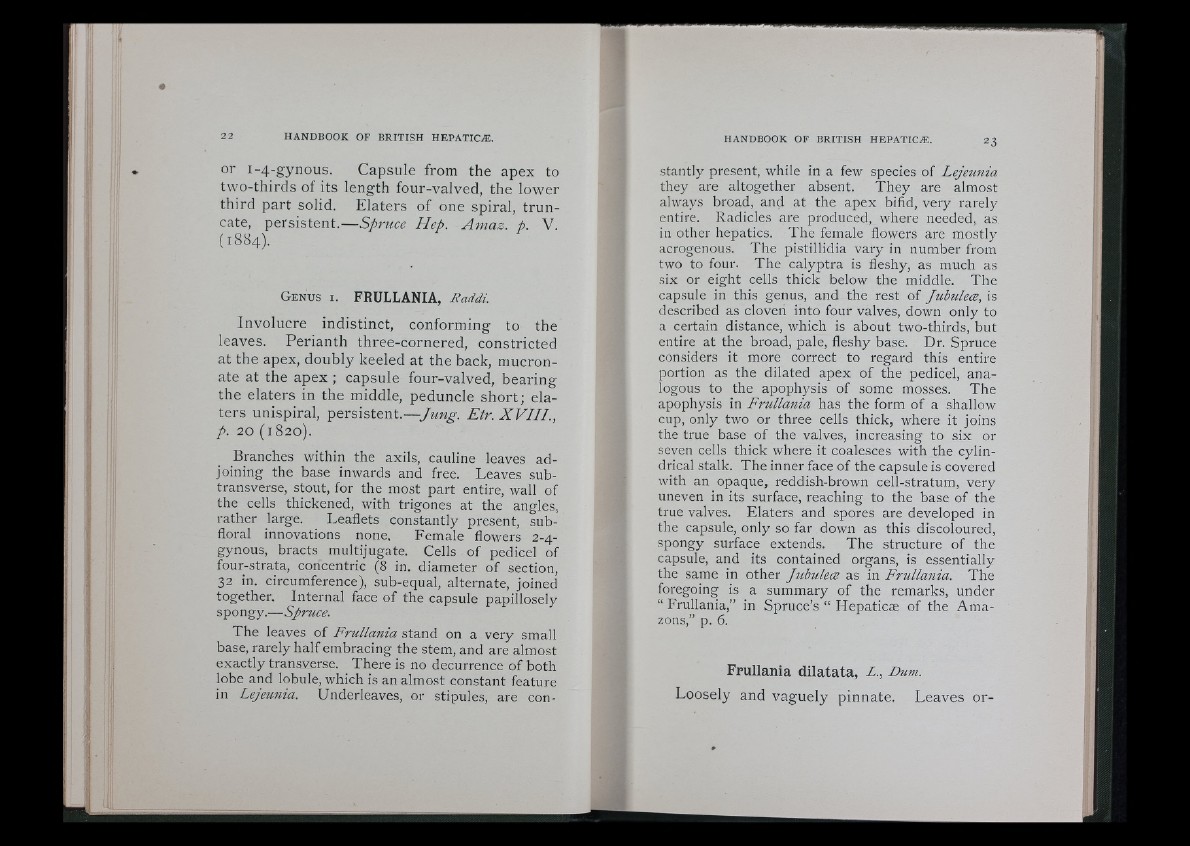
or i -4 -g yn o u s . Capsule from the apex to
two- thirds of its length four-valved, the lowe r
third part solid. Elaters of one spiral, truncate,
per s is tent .— Spruce Hep. Am a z . p. V.
(1884).
G en u s i. FRULLANIA, Raddi.
Involuc re indistinct, conforming to the
leaves. Per ianth three-cornered, constricted
at the apex, doubly keeled at the back, mucron-
ate at the apex ; capsule four-valved, bearing
the elaters in the middle, peduncle shor t ; elaters
unispiral, per sis tent .— Ju n g . Etr. X V I I I . ,
p. 20 (1820).
Branches within the axils, cauline leaves adjoining
the base inwards and free. Leaves sub-
transverse, stout, for the most part entire, wall of
the cells thickened, with trigones at the angles,
rather large. Leaflets constantly present, subfloral
innovations none. Female flowers 2-4-
gynous, bracts multijugate. Cells of pedicel of
four-strata, concentric (8 in. diameter of section,
32 in. circumference), sub-equal, alternate, joined
together. Internal face of the capsule papillosely
spongy.— Spruce.
The leaves of Frullania stand on a very small
base, rarely half embracing the stem, and are almost
exactly transverse. There is no decurrence of both
lobe and lobule, which is an almost constant feature
in Lejeu?iia. Underleaves, or stipules, are constantly
present, while in a few species of Lejeunia
they are altogether absent. They are almost
always broad, and at the apex bifid, very rarely
entire. Radicles are produced, where needed, as.
in other hepatics. The female flowers are mostly
acrogenous. The pistillidia vary in number from
two to four. The calyptra is fleshy, as much as
six or eight cells thick below the middle. The
capsule in this genus, and the rest of Jubuleæ, is
described as cloven into four valves, down only to
a certain distance, which is about two-thirds, but
entire at the broad, pale, fleshy base. Dr. Spruce
considers it more correct to regard this entire
portion as the dilated apex of the pedicel, analogous
to the apophysis of some mosses. The
apophysis in Frullania has the form of a shallow
cup, only two or three cells thick, where it joins
the true base of the valves, increasing to six or
seven cells thick where it coalesces with the cylindrical
stalk. The inner face of the capsule is covered
with an opaque, reddish-brown cell-stratum, very
uneven in its surface, reaching to the base of the
true valves. Elaters and spores are developed in
the capsule, only so far down as this discoloured,
spongy surface extends. The structure of the
capsule, and its contained organs, is essentially
the same in other Jubuleæ as in Frtdlania. The
foregoing is a summary of the remarks, under
“ Frullania,” in Spruce’s “ Hepaticse of the Ama zons,”
p. 6.
Frullania dilatata, L., Dum.
Loosely and v a gu e ly pinnate. Lea v e s or